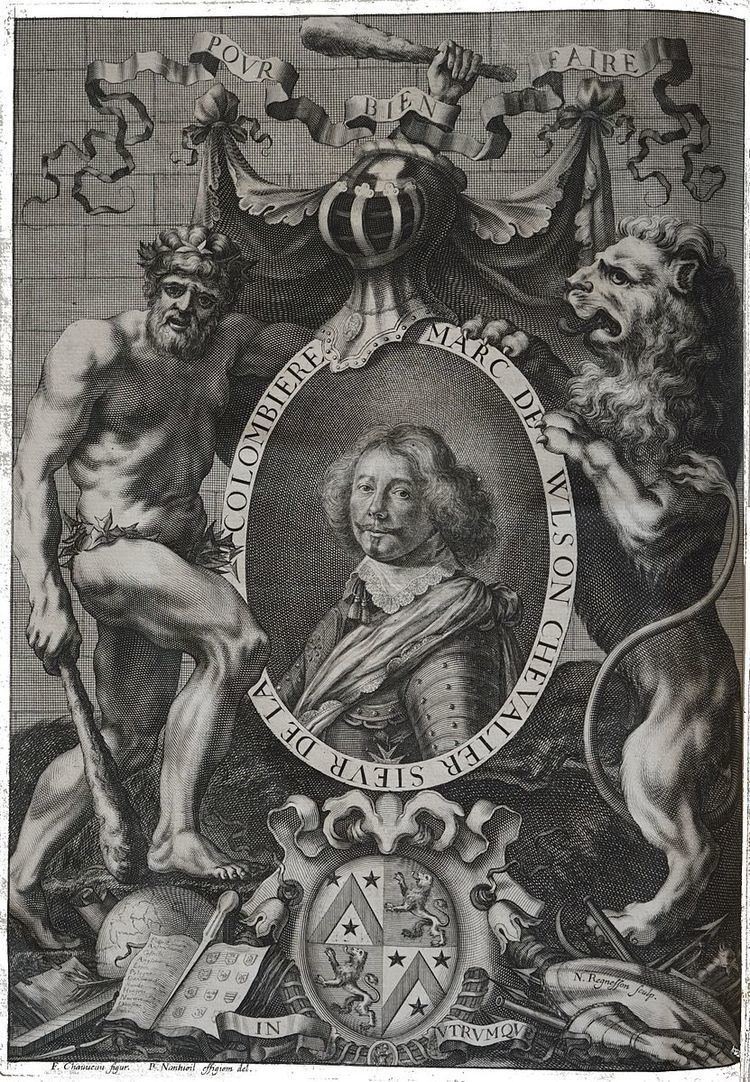Name Marcus de | ||
Marc Vulson de la Colombière (†1658) or Sieur de la Colombière was a French heraldist, historian, poet, minion of the royal court. His name is sometimes spelt as Wulson and also as Volson.
Contents

He published several highly successful books on symbols, prophecies, heraldry, dreams etc. He put together all the available knowledge and traditions associated with chivalry. In the 17th century chivalry was practically rediscovered by two genealogists in the French court: Vulson de la Colombière and Claude-François Ménestrier after its golden age (1100–1400) and the decline of chivalry, developing its idealized image. Some authors named Vulson de la de la Colombière as the inventor of hatching system of tinctures.
Biography
We have only some fragmented data about his life. Even the 19th century big biographies deliver only incomplete information about him. He was born in a Protestant noble family at the end of the 16th century in Dauphiné. He was a son of François, advocat and Michelle Odde de Bonniot. In his youth, he fought for Henry IV. According to a curious anecdote, in 1618 he went to Paris to request grace, after he killed his treacherous wife and her lover.
According to the title pages of his books, (see for example Le Vray Théâtre d´honneur et de Chevalerie, Paris, 1648), he was a member of the parliament in Paris and the member of the Order of Saint Michael (gentilhomme de la Chambre du Roi et Décoré de l’Ordre de Saint-Michel). By all probability, until 1635 he was staying in Grenoble as he was a royal counselor in the Dauphiné parliament (conseiller du roi en la cour de parlement de Dauphiné). He also published a book in the spirit of the Gallicanism in Geneva that year. (It can be noted that several of the Protestant priests and students at the Geneva University were his kinsmen.) Gallicanism served as a proper means to express his Protestant views in opposition to Catholicism, and he presented them in such a way that it was even appreciated by the state establishment too.
Vulson de la Colombière’s ideas suited the king’s taste too, as a result he left Grenoble and settled down in Paris, where he devoted his entire energy to study heraldry. According to the catalogues of the Bibliothèque Nationale de France, his next book was published in Paris in 1638.
The Dispute of Vulson de la Colombière and Petra Sancta
He had wide-ranging correspondence with the most renowned heraldists of his time. For this reason, it could perhaps be concluded that Vulson de la Colombière was right in claiming the title of the inventor of the hatching system, and accusing Silvester Petra Sancta of copying his method and incorrectly publishing it in his 1638 work, one year before the same hatching system was published by Vulson de la Colombière. On page 37 of his title La Science Heroïque (1644), Vulson de la Colombière maintains that Petra Sancta simply copied his system without any changes. Vulson de la Colombière also maintains that he showed to Petra Sancta his hatching system in the past. In his citation, Vulson de la Colombière also mentions the book publishers and copperplate engravers as the users of the hatching system, thus emphasizing that by using this method on the illustrations, engravers can always designate the tinctures of the copperplates in the same coherent manner. In the title of his 1639 book he directly mentions that hatching is a new method used by copperplate engravings ("suivant l'art des anciens roys d'armes... et une nouvelle méthode de cognoistre les métaux et couleurs sur la taille-douce"). The book was published by Melchior Tavernier, and the engraved fontoispiece was made by Abraham Bosse. Maybe he was also the author of the remaining engravings inside the book. However, Vulson de la Colombière contributed to the drawing and engraving of illustrations too, as we can see from his signature under the armorial genealogical table of his supporter, Denys de Salvaing.
In his 1639 title, Vulson de la Colombière published a hatching table, but did not mention Petra Sancta. The reason probably was that in 1638 the publication of his book was already in progress and/or he did not know nothing about the same hatching method published by Petra Sancta in 1638. He had also described the way of hatchings by words, and published another hatching table in 1644.
Ottfried Neubecker maintains that the hatching system in heraldry was invented by Vulson de la Colombière and not Petra Sancta who only popularized the system through his second treatise titled Tesserae gentilitia, published in 1638.
